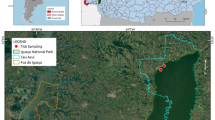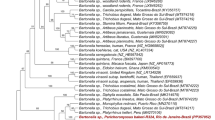Abstract
Haemaphysalis bispinosa Neumann has been considered to exist in China, especially in the southern part of the country. However, H. bispinosa referred to in many Chinese research papers may in fact be H. longicornis, which is widely distributed in most regions of China. In order to clarify the occurrence of H. bispinosa, Haemaphysalis ticks collected from 18 of 23 provinces of China (Hebei, Henan, Hubei, Guangxi, Gansu, Yunnan, Xinjiang, Anhui, Zhejiang, Shannxi, Guizhou, Sichuan, Shanxi, Shandong, Ningxia, Fujian, Qinghai and Jiangxi) were examined based on morphological and molecular characteristics. We found no evidence of H. bispinosa being present in China. Our results indicate that all of the so called “H. bispinosa” ticks reported in China are in fact H. longicornis.

Similar content being viewed by others
References
Black WC, Piesman J (1994) Phylogeny of hard and soft-tick taxa (Acari: Ixodidae) based on mitochondrial 16S rDNA sequences. Proc Natl Acad Sci USA 91:10034–10038
Brahma RK, Dixit V, Sangwan AK, Doley R (2014) Identification and characterization of Rhipicephalus (Boophilus) microplus and Haemaphysalis bispinosa ticks (Acari: Ixodidae) of North East India by ITS2 and 16S rDNA sequences and morphological analysis. Exp Appl Acarol 62:253–265
Burger TD, Shao R, Beati L, Miller H, Barker SC (2012) Phylogenetic analysis of ticks (Acari: Ixodida) using mitochondrial genomes and nuclear rRNA genes indicates that the genus Amblyomma is polyphyletic. Mol Phylogenet Evol 64:45–55
Chen Z, Yang X, Bu F, Yang X, Yang X, Liu J (2010) Ticks (Acari: Ixodoidea: Argasidae, Ixodidae) of China. Exp Appl Acarol 51:393–404
Chen Z, Yang X, Bu F, Liu J (2012) Morphological, biological and molecular characteristics of bisexual and parthenogenetic Haemaphysalis longicornis. Vet Parasitol 189:344–352
Geevarghese G, Mishra AC (2011) Haemaphysalis ticks of India. Elsevier, London
Guglielmone AA, Robbins RG, Apanaskevich DA, Petney TN, Estrada-Peña A, Horak IG (2010) The Argasidae, Ixodidae and Nuttalliellidae (Acari: Ixodida) of the world: a list of valid species names. Zootaxa 2528:1–28
Herrin CS, Oliver JH (1974) Numerical taxonomic studies of parthenogenetic and bisexual populations of Haemaphysalis longicornis and related species (Acari: Ixodidae). J Parasitol 60:1025–1036
Hoogstraal H, Roberts FHS, Kohls GM, Tipton VJ (1968) Review of Haemaphysalis (Kaiseriana) longicornis Neumann (Resurrected) of Australia, New Zealand, New Caledonia, Fiji, Japan, Korea, and Northeastern China and USSR, and its parthenogenetic and bisexual populations (Ixodoidea, Ixodidae). J Parasitol 54:1197–1213
Jiang W, Wang Z, Wang X, Liu W, Wang D, Zhuang Y (2009) The investigation of Haemaphysalis bispinosa seasonal fluctuation at Dagan Town of Guizhou province from 2006 to 2007. Chin J Vector Biol Control 20:70–71 (in Chinese)
Kulakova NV, Khasnatinov MA, Sidorova EA, Adelshin RV, Belikov SI (2014) Molecular identification and phylogeny of Dermacentor nuttalli (Acari: Ixodidae). Parasitol Res 113:1787–1793
Li Y (1991) Lyme disease spirochetes isolated from Haemaphysalis bispinosa in the forest area of East Sichuan. Chin J Vector Biol Control 2:386–387 (in Chinese)
Li C, Zhang H, Han D, Qian W, Liu A (1987) Comparative studies on morphology of Haller’s organs of six hard ticks. J Kunming Med Coll 8:22–26 (in Chinese)
Li Y, Wan K, Li X (2001) Premary study on the ecological habit and character of Haemaphysalis bispinosa. Chin J Vector Biol Control 12:432–434 (in Chinese)
Liu Z, Ma Y, Ma T (1984) Observations on the developmental stages of Haemaphysalis bispinosa. Chin J Vet Sci Technol 6:15–17 (in Chinese)
Liu Z, Song J, Peng W (1993) Cross immune reaction between Ixodes sinensis and Haemaphysalis bispinosa. Acta Entomol Sin 36:290–295 (in Chinese)
Liu Z, Ye B, Cui X, Xu M (2004) Experimental study on the cross immune reaction between Ixodes sinensis and Haemaphysalis bispinosa. Chin J Biol Control 20:95–98 (in Chinese)
Lu X, Lin X, Wang J, Qin X, Tian J, Guo W, Fan F, Shao R, Xu J, Zhang Y (2013) Molecular survey of hard ticks in endemic areas of tick-borne diseases in China. Ticks Tick-borne Dis 4:288–296
Lv J, Wu S, Zhang Y, Chen Y, Feng C, Yuan X, Jia G, Deng J, Wang C, Wang Q (2014a) Assessment of four DNA fragments (COI, 16S rDNA, ITS2, 12S rDNA) for species identification of the Ixodida (Acari: Ixodida). Parasit Vectors 7:93
Lv J, Wu S, Zhang Y, Zhang T, Feng C, Jia G, Lin X (2014b) Development of a DNA barcoding system for the Ixodida (Acari: Ixodida). Mitochondrial DNA 25:142–149
Robbins RG (2005) The ticks (Acari: Ixodida: Argasidae, Ixodidae) of Taiwan: a synonymic checklist. P Entomol Soc Wash 107:245–253
Tamura K, Stecher G, Peterson D, Filipski A, Kumar S (2013) MEGA6: molecular evolutionary genetics analysis version 6.0. Mol Biol Evol 30:2725–2729
Teng KF (1955) Studies on the life history of Haemaphysalis bispinosa Neum. Acta Entomol Sin 5:165–181 (in Chinese)
Teng KF (1978) Economic insect fauna of China. Fasc 15 Acari: Ixodoidea. Science Press, Beijing (in Chinese)
Teng KF, Jiang ZJ (1991) Economic insect fauna of China. Fasc 39 Acari: Ixodidae. Science Press, Beijing (in Chinese)
Yang Y, Li D (1989) Comparative studies on the life cycle and morphological features of Haemaphysalis bispinosa and H. longicornis in China. Bull Vet Coll PLA 9:1–6 (in Chinese)
Yang CM, Yang GY, Xie YX, Wu KB, Jia XY (2007) Morphological observation of parthenogenetic Haemaphysalis longicornis with scanning electron microscope. Acta Parasitol Med Entomol Sin 14:104–109 (in Chinese)
Yang X, Chen Z, Liu J (2008) The valid genus and species names of ticks (Acari: Ixodida: Argasidae, Ixodidae) in China. J Hebei Normal Univ (Nat Sci) 4:529–533 (in Chinese)
Yu X, Ye RY, Gong ZD (1997) The ticks fauna of Xinjiang. Xinjiang Scientific, Technological and Medical Publishing House, Urumqi (in Chinese)
Zhang RL, Zhang B (2014) Prospects of using DNA barcoding for species identification and evaluation of the accuracy of sequence databases for ticks (Acari: Ixodida). Ticks Tick-borne Dis 3:352–358
Zheng H, Yu Z, Chen Z, Zhou L, Zheng B, Ma H, Liu J (2011) Development and biological characteristics of Haemaphysalis longicornis (Acari: Ixodidae) under field conditions. Exp Appl Acarol 53:377–388
Zhou JL, Zhou YZ, Gong HY, Chen LZ, Cao J (2004) Discovery of parthenogenesis population of Haemaphysalis longicornis in China and its biological characteristic. Chin J Vector Bio Control 15:173–174 (in Chinese)
Acknowledgments
We thank Professor Jingze Liu kindly for providing tick specimens. This study was financially supported by the NSFC (Nos. 31101621, 31471967, 31372432, 31201899, 31272556), ASTIP, CAAS; Creative Research Groups of Gansu Province (No. 1210RJIA006); “948” (2010-S06), NBCIS CARS-38, Special Fund for Agro-scientific Research in the Public Research (Nos. 201303035, 201303037), MOA; 973 Program (2010CB530206), Basic Research program (CRP No. 16198/R0), Supporting Program (2013BAD12B00), Specific Fund for Sino-Europe Cooperation, MOST, China; State Key Laboratory of Veterinary Etiological Biology Project. The research was also facilitated by CRP No. 16198/R0 IAEA, and PIROVAC (KBBE-3-245145) of European Commission.
Author information
Authors and Affiliations
Corresponding authors
Rights and permissions
About this article
Cite this article
Chen, Z., Li, Y., Ren, Q. et al. Does Haemaphysalis bispinosa (Acari: Ixodidae) really occur in China?. Exp Appl Acarol 65, 249–257 (2015). https://doi.org/10.1007/s10493-014-9854-3
Received:
Accepted:
Published:
Issue Date:
DOI: https://doi.org/10.1007/s10493-014-9854-3




